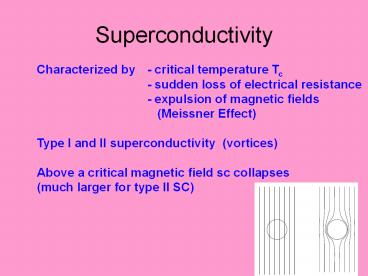Superconductivity
Title:
Superconductivity
Description:
problem of condensed matter physics. BCS theory (Bardeen, Cooper, Schrieffer) ... in Condensed Matter Physics. ( Phase diagram' of theories) Un-explained Phenomena ... –
Number of Views:475
Avg rating:3.0/5.0
Title: Superconductivity
1
Superconductivity
Characterized by - critical temperature Tc -
sudden loss of electrical resistance -
expulsion of magnetic fields (Meissner
Effect) Type I and II superconductivity
(vortices) Above a critical magnetic field sc
collapses (much larger for type II SC)
2
Technological Importance
- Lossless energy conduction
- Miniaturization (downtown in space)
- Effective Transportation (MagLevs)
- Strong Magnetic Fields (fusion, MRI)
- Thin Film detector technology/nano-tech
Basic Research Importance
Macroscopic Quantum Effect A basic state of
all matter?
3
Theory of SC
Until 1986 SC was considered the one completely
solved problem of condensed matter physics. BCS
theory (Bardeen, Cooper, Schrieffer) a QM
many-body theory - predicted Tc and a
theoretical limit for Tc - below Tc 2 cond. e-
of opposite impulse and spin build Cooper pair
and correlate to a macroscopic liquid that needs
to be excited collectively (and thus obey a
different statistic Fermi Liquid) - at Tc
energy gap D, BCS value 3.52 kBTc 2 D -
mediation of process through e--phonon coupling
4
Validation of BCS Theory
- All known SC (elemental metals, alloys,
compounds) - obeyed the law of max. Tc
- NMR experiments measured and confirmed
- the energy gap
- Late 1980s Exotic SC emerges
- In rapid succession several classes of SC were
- discovered which did not obey BCS theory.
- Heavy Fermions - HTSC
- Organic SC - ladder compounds
- Today SC is perhaps the least understood
phenomenon - in Condensed Matter Physics. (Phase diagram of
theories)
5
Un-explained Phenomena
Mediation process e- -phonon? e- - e- ? Energy
gap symmetry s-wave? d-wave? p-wave? Energy
gap nature spin-gap pseudo-gap Origin of
SC out of all things emerging from AFM
??? Nature of coupling FL non-FL Limit for
Tc unknown, nobody knows how to calculate
6
Electronic Structure
7
Transport Probes
- Resistivity
- Susceptibility
- Specific Heat
- Thermopower
8
Resistivity
9
Susceptibility Measurement
Induced sample (magn.) moments are time
dependent ? AC probes magnetization dynamics, DC
does not
10
Specific Heat
11
Thermopower
12
Spectroscopic Probes
- Photoemission (esp ARPES)
- Tunneling Spectroscopy
- Neutron Scattering
- NMR line shift
- NMR relaxation
- And all other spectrocopies like EPR, Moessbauer,
Raman but these - are all less direct methods for probing e-
- or in bad need for calibration to be quantitative
13
ARPES
Shine photons of specific energy on sample If E gt
work function, e- will be emitted E is measured
and tells about initial E in crystal
Problems photocurrent is very complicated
quantity surface sensitive
probe Advantage momentum and frequency resolved
probe comparable only to ineleastic n-scattering
14
Tunneling Spectroscopy
Advantage Direct measurement of sc
DOS Problems Surface technique
15
Neutron Scattering
Advantage momentum and frequency resolved
probe Problems Needs large single
crystals requires n reactor (measuring
time) measures a complicated function wide
elemental sensitivity range
16
Nuclear Magnetic Resonance
Advantage solid theoretical understanding wide
variety of methodology tests bulk dynamic
(relaxation) and static (shift)
probe Problems wide elemental sensitivity
range requires magnetic field
Well understood behavior for metals As function
of temperature As function of magnetic field As
function of pressure
17
NMR HTSC pseudo-gap gap symemtry gap size
18
New models of SCwhich try to address the new
phase diagrams
Stripes (charge order)
Approach how does a Mott Insulator (ie a
substance which should have been a conductor but
isnt) turn into a SC?
Kinetic energy favors FL vs Coulomb repulsion b/w
e- which favors insulating magnetic or charged
ordered states stripes are such density-wave
states (charge, spin)
19
RVB vs QCP
QCP continuous phase transition at
T0K driven by zero-point q fluctuations b/c
of uncertainty relation
RVB coherent singlet ground state
20
Pseudogap
21
Organic SC
H Mori
22































